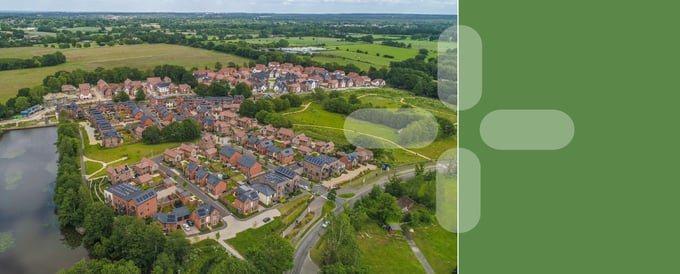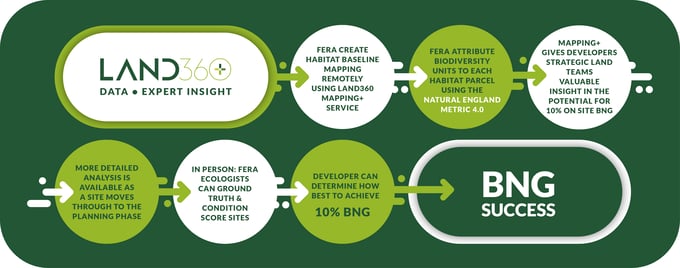Embracing science, data and ecological expertise will help developers rise to the challenge of incoming biodiversity net gain (BNG) requirements, which go live on 12th February 2024.

Policy on biodiversity net gain for developers
New legislation launching on 12th February 2024, under the Town & Country Planning Act (TCPA), will require housing developers in England to deliver at least a 10% increase in biodiversity on all sites for 30 years minimum.
This mandatory requirement will firstly be applicable to new planning applications for major development – meaning residential developments that comprise of 10 or more dwellings, or site areas of more than 0.5 hectares.
Then, from April 2024, the BNG legislation extends to smaller sites, nationally significant infrastructure projects, and the following exclusions:
- If the development impacts a habitat smaller than 25 metres squared, or 5 metres for more linear habitats (e.g. hedgerows or watercourses)
- Development applications from individual householders e.g. small scale self-build projects
- Biodiversity gain sites (developed specifically for enhancing wildlife habitats)
On top of the national requirement, increasing numbers of local authorities across England have adopted a BNG policy that requires more than the minimum standard of 10% gain.
To ensure compliance, developers must provide an extensive BNG plan for each site to gain planning permission. This must include a bespoke, site-specific net gain strategy and evidence of how this will achieve at least a 10% uplift in biodiversity.
planning permission. This must include a bespoke, site-specific net gain strategy and evidence of how this will achieve at least a 10% uplift in biodiversity.
How to complete a biodiversity net gain plan
Creating a biodiversity net gain plan involves assessing and calculating initial biodiversity levels, using the mitigation hierarchy to build an effective biodiversity gain strategy, and creating a bespoke habitat management and monitoring plan for the long term.
Defra has published a biodiversity gain plan template for developers as guidance, which you can find here. However, it’s worth noting that developers still need to source an extensive list of evidence to be able to complete the draft template.
This evidence includes:
- A completed Biodiversity Metric 4.0 calculation
- A pre-development habitat map plan
- A net biodiversity net gain strategy that sets out the steps being taken to avoid or minimise habitat impact
- A predicted post-development habitat map, showing biodiversity uplifts
- A habitat management plan
- A habitat monitoring plan
It’s a complex undertaking – so Defra recommends developers seek scientific support to firstly capture highly accurate biodiversity data and then build an effective biodiversity gain plan that’s informed by science, to ensure compliance with the 2024 BNG regulations.
Meet biodiversity net gain requirements with science
For developers, harnessing environmental science within every step of the biodiversity net gain planning process will be key to success.
According to legislation, developers who fail to account for BNG in their plans will face delays or even rejection of their applications, so getting credible advice from experts in this field is vital for developers and planners.
Investing in scientific support with BNG planning will not only help developers meet industry-wide regulations smoothly, but also help demonstrate a true ‘nature first’ approach to sustainable development, backed up with genuine expertise.
With over 100 years of scientific undertaking, research and development, Fera is in the perfect position to help housebuilders to understand and navigate BNG policy changes with tailored support.
Fera’s LAND360 land assessment service connects developers with our team of economists, GIS and remote sensing experts, and ecologists, to help them map on-land biodiversity, supporting the creation and delivery a 30-year biodiversity gain plan.
We leverage cutting-edge technologies such as remote sensing, spatial analysis, mapping, and geographic information systems (GIS) to gather a comprehensive range of data, without the need for initial on-site investigation.
We start with collating baseline information, using geospatial data to investigate the range of habitats present across a development site. Remote sensing allows us to interpret the landscape remotely using satellite data and by using geographic information systems (GIS) we can combine the land mapping, derived for the satellite data, with ecological assessments. This data is directly compatible with the Natural England Biodiversity Metric 4.0 at different stages throughout the process, giving insights at different decision-making points.

This insight is then paired with expert advice from Fera to help housing developers understand the potential of their sites to meet net gains in biodiversity of at least 10% and create a benchmark to track and evidence progress from.
Support for developers with BNG requirements
Invest in scientific expertise now to help with designing a BNG plan in accordance with best practice principles and standards.
Learn how LAND360, a vital tool in the quest for sustainable development and biodiversity enhancement, can help you achieve compliance here: https://www.fera.co.uk/land360-housing-developers
More about LAND360
LAND360 is Fera's cutting-edge natural capital assessment service. Launched in 2022, it empowers farmers, landowners, estate managers, and housing developers to make informed land use decisions. By accurately measuring and mapping existing land habitat features and modelling biodiversity offerings, LAND360 is a vital tool in the quest for sustainable development and biodiversity enhancement.
